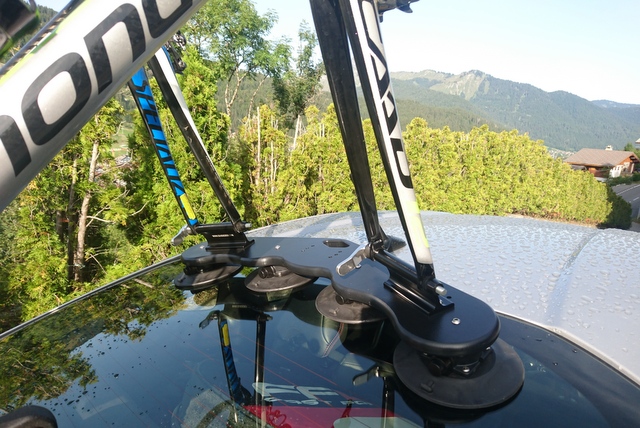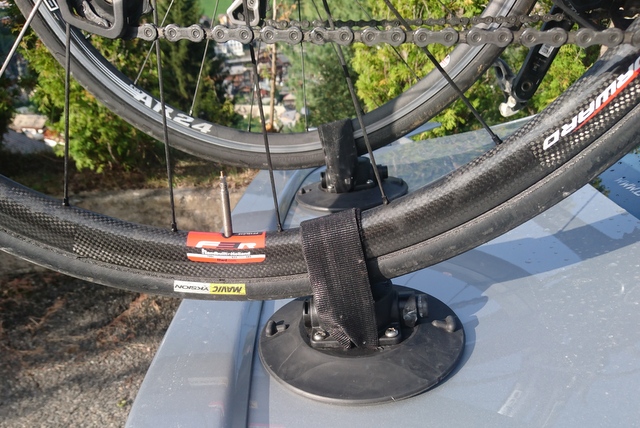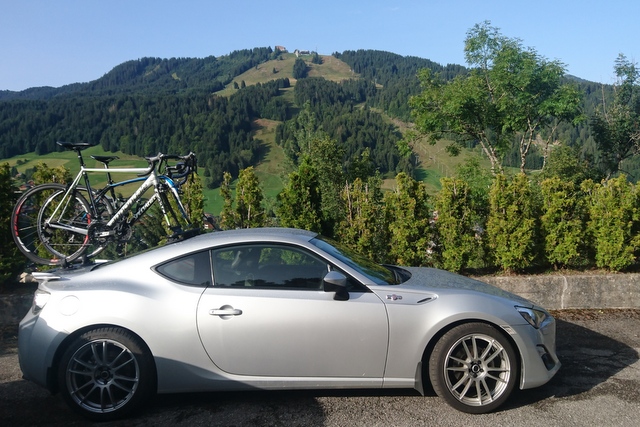SeaSucker Mini Bomber 2 Bike Rack review
The SeaSucker Mini Bomber bike rack journeyed with us over 1,900 miles across un-restricted autobahns of Germany: testing was thorough

If you can get over the concept of attaching your bike to the roof with no nuts and bolts - which I could - you'll discover a bike rack which is incredibly easy to use, transport and store. There's no way of locking the bike (without purchasing ad ons) which is a mild inconvenience but it sits at a price I would be very happy to pay - especially for the time and space saved with this rack.
-
+
Very light
-
+
Easy to store when not in use
-
+
Quick to attach
-
+
Reliable
-
-
Can't lock the bike without ad ons
You can trust Cycling Weekly.

Apparently the bikes on the car must always be worth more than the vehicle itself - but the existence of such a rule doesn't mean there aren't automobile conscious cyclists out there. Some of us like driving and riding - and what these people need is a reliable bike rack that isn't permanently fixed or unsightly.
Once a year, my partner in crime and I embark upon a bike assisted road trip. Driving between bucket-list attractions, parking up, riding, and usually stopping for beer, pizza and occasional sleep.
Such trips require a bike rack which is quick and easy to attach to the Toyota GT86 in question, ideally one which doesn't increase drag too much and thus fuel consumption.
This year our trip took us to Morzine, Bormio (home of the Stelvio and Gavia), and Germany for the infamous Nürburgring - and we opted to test out the SeaSucker Mini Bomber along the way.
SeaSucker Mini Bomber 2 Bike Rack: what's in the box
The SeaSucker Mini Bomber is a unique bike rack which uses vacuum suction cups to attach the precious cargo to the roof of a car – no nuts and bolts required.
The Florida based brand offers the racks in a selection of orientations – to suit anywhere between one and three bikes - and they can all be fitted to any car.

The Mini Bomber two-bike rack comes with a front plate, which uses four suckers – the outer two housing quick release fork mounts designed to suit 9mm drop outs - and two suction pads for the rear wheels.
The latest race content, interviews, features, reviews and expert buying guides, direct to your inbox!
To attach the suckers, you simply push down on the body of the mount, and press a small pump to seal the unit; an indicator line shoes when attachment has been successful.
The bikes are loaded up by removing the front wheel, slipping the fork into the fork mount, tightening the quick release and strapping the rear wheel to the second sucker.

The rack can be used on the roof or car boot and the box also contains a crank arm strap which can be used to prevent the crank hitting the roof of the car if this is a risk.
The unit can cater for bikes up to 45 lbs (20kg) each, and weighs 12lbs (5.4kg) itself, with a footprint of 30” x 9”.
The suckers are rated to 210lb pull-strength – meaning they’d require a pretty incredible amount of force if they were to ever be removed without intention. Indeed, we'd hazard a guess that less force would be required to snap the forks in two.
SeaSucker Mini Bomber 2 Bike Rack: the ride

This summer, Cycling Weekly put the two-bike version through some pretty vigorous testing, but we’ve also tried the single steed option too.
Before setting off, we left the rack suctioned to our living room window for about a week - just to make sure it worked. Such is the disconcerting nature of entrusting thousands of pounds worth of bike to untested physics.
Fitting the rack was pretty simple, but due to the curve of the rear window, a fair amount of force had to be placed on the body of the rack when attaching the outside suckers. My partner managed fine but I always found it quite difficult. However, testing it on the flatter roof of my own (more practical) car the issue was eliminated.
There was no hassle in securing the bikes. The Velcro straps provided for the rear wheels were sufficient, but you can also purchase ratchets in the SeaSucker spares store which I’d be inclined to do for future use.
From the passenger seat, it's quite notable that the bikes do wobble around - but the suckers never budged.
Taking on the autobahns of Germany, we were more conservative with speed – mindful of the 80mph max speed suggested by SeaSucker. This said, we did (legally) cruise at 150kph/93mph without suffering any ill effects.
Aerodynamics of the car were hardly affected - the overall figure being 32 miles per gallon across the 1,900 odd miles driven (including a few laps of the Nürburgring which probably had more effect than the rack).
One issue we came across was the inability to attach any sort of locking system when using the SeaSucker as it is. A thief wishing to lift the bikes would only need a dose of courage and a basic understanding of bikes.
Another slight gripe is that the front wheels need to sit on the back seats (if in a small car) – this will suit some people perfectly well, but does add to the general jumble-sale appearance created in the rear of the car on a long trip.
Both of these could be solved with add ons - SeaSucker sells a front wheel attachment as well as a cable anchor which can sit lodged in the boot door. The former looks great - the latter feels a bit risky, should someone attempt to yank it free.
These complications cast aside, the SeaSucker Mini Bomber was by far the easiest rack we’ve ever used. Aside from potential detriment to peace of mind posed by suspending bikes to the roof of the car via suction, it was the safest too. Plus, now we're home it takes up minimal space in the all-purpose cupboard-under-the-stairs.
Michelle Arthurs-Brennan the Editor of Cycling Weekly website. An NCTJ qualified traditional journalist by trade, Michelle began her career working for local newspapers. She's worked within the cycling industry since 2012, and joined the Cycling Weekly team in 2017, having previously been Editor at Total Women's Cycling. Prior to welcoming her first daughter in 2022, Michelle raced on the road, track, and in time trials, and still rides as much as she can - albeit a fair proportion indoors, for now.
Michelle is on maternity leave from April 2025 until spring 2026.
